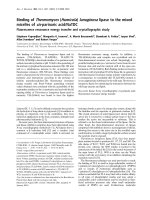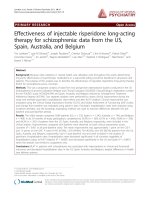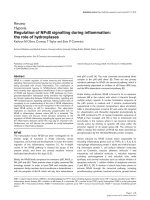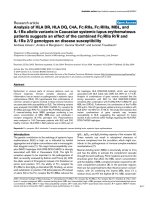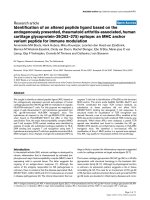Báo cáo y học: " Effectiveness of an intercultural module added to the treatment guidelines for Moroccan and Turkish patients with depressive and anxiety disorders" ppt
Bạn đang xem bản rút gọn của tài liệu. Xem và tải ngay bản đầy đủ của tài liệu tại đây (199.58 KB, 7 trang )
STUDY PROT O C O L Open Access
Effectiveness of an intercultural module added to
the treatment guidelines for Moroccan and Turkish
patients with depressive and anxiety disorders
Annelies van Loon
1*
, Digna JF van Schaik
1,4
, Jack J Dekker
2,3
, Aartjan TF Beekman
1,4
Abstract
Background: Since the sixties of the last century, many people from Morocco and Turkey have migrated into the
Netherlands. In the last decade, Moroccan and Turkish patients have found their way to organizations for mental
health care. However, they often drop out of treatment. Problems in the communication with therapists and different
expectations regarding treatment seem to be causal factors for the early drop -out of therapy. In the Netherlands as
in other countries courses have been developed for training cultural competence of therapists. Yet, up to now, the
effectiveness of increased cultural competence of therapists in reducing drop-out of treatment has not been studied.
Methods/Design: A randomized clinical trial was started in January 2010. Moroccan and Turkish adult patients who
are referred to our outpatient clinics for mood and anxiety disorders are randomly assigned to mental health workers
who are trained in a cultural module and to those who are not. The therapists have been trained in the Cultural
Formulation and in techniques bridging the (cultural) gap between them and their Moroccan and Turkish patients.
The target number of participants is 150 patients, 75 for each group. Drop-out of treatment is the primary
outcome measure. Secondary outcome measures are no-show and patients’ perspective of care.
Discussion: The study will give an answer to the question whether increasing cultural competence of therapists
reduces drop-out of treatment in Moroccan and Turkish outpatients with depressive and anxiety disorders.
Trial Registration: The Dutch Cochrane Centre, NTR1989
Background
Since the beginning of the 1960 s, large groups of male
labour immigrants from Morocco and Turkey have
come to the Netherlands. In the beginning they left
their wives and children behind to be cared for by rela-
tives, later they reunited with their families in the
Netherlands. They settled down in the large cities such
as Amsterdam, because relatively more unskilled labour
jobs were available there. After the reunion with the
families there was a decrease in immigration o f this
kind of immigrants around 1985. However, the migra-
tion from Morocco and Turkey unexpectedly rose again
because children of the immigrants often married men
or women from Morocco or Turkey. This contributed
to a prolonged migration. As a result there is a first, a
second and a third generation although it is hard to
strictly separate these generations [1,2]. In 2010 about
349.000 Moroccans and 384.000 Turkish (first and sec-
ond generation) reside in The Netherlands [3]. In
Amsterdam 9.0% is of Moroccan and 5.2% of the popu-
lation is of Turkish descent [4]. The Moroccan and
Turkish population form the largest group of immi-
grants in the Netherlands as well as in Amsterdam.
It is known that migration can be a stressful process
that can lead to mental illness [5,5]. Previous studies in
Belgium and the Netherlands have found that common
mental disorders are more prevalent among Moroccan
and Turkish immigrants [6,7]. Other studies have shown
that these groups have found their way to the mental
health services [8,9] but treatment intensity seems to be
less favourable [10] and high rates of treatment drop-
out were found: 46%, among immigrant patients in spe-
cialized mental health service use compared to 24%
among Dutch patients [11,12]. The high drop-out rates
* Correspondence:
1
Research Department, GGZ inGeest, Amsterdam, The Netherlands
Full list of author information is available at the end of the article
van Loon et al. BMC Psychiatry 2011, 11:13
/>© 2011 van Loon et al; licensee BioMed Central Ltd. This is an Open Access article distributed under the terms of the Creative
Commons Attribution License ( which permits unrestricted use, distribution, and
reproduction in any medium, provided the original work is properly cited.
can lead to higher risks of chronicity of symptoms and
prolonged disabilities.
The high drop-out rates among immigrants may be due
to language problems, to different interpretations of
symptoms and t o different expectations of treatment
[13].Adequatetreatmentcanonlybegivenwhenafirm
and steady working-relation can be established. It is
thought that training therapists in cultural competences
will bridge the gap between immigrant patients and their
therapists. Without this competence health practitioners
can easily f all prey to e rrors of diagnosis, inappropriate
and poor tr eatment [14]. Training modules in intercul-
tural competence course s have been developed for (men-
tal) health workers. Therapists learn about the cultural
background of specific immigrant groups. They learn to
be aware of different notions of health and illness and
they are trained in specific intercultural skills. Although
widely applied there is, up to now, no evidence that train-
ing in cultural competence reduces drop-out of treat-
ment or improves treatment outcome [15,16].
Theaimofthisstudyistotestwhetheracultural
comp etence training for therapists can reduce the treat-
ment drop-out in Moroccan and Turkish patients with
depressive and anxiety disorders in specialized mental
health care. In order to test the effectiveness of this
course we des igned a randomize d controlled trial. Our
research questions are:
1. Does the intercultural competences training of
therapists reduce treatment drop-out rates of Mor-
occan and Turkish patients with depressive and
anxiety disorders in specialized mental health care?
2. Does the intercultural competences training of
therapists reduce no-show rates, enhance the patient-
therapist working alliance and patients’ trust in care?
3. What are determinants of treatment dropout?
Method/Design
Study design
Thi s study is a multi-centre randomized controlled trial
in which treatment drop-out rates of Moroccan and
Turkish immigrants with depressive and anxiety disor-
ders, who are treated by therapists trained in cultural
competences, are compared to those who receive regular
care. Figure 1 shows the design.
Recruitment/Setting and locations
Participants are recruited within two outpatient mood
disorder clinics in Amsterdam. All new Moroccan and
Turkish registries, mostly referre d by their general prac-
titioner, are screened on in- and exclusion criteria. If eli-
gible, the new registries are randomized by a research
assistant before the intake procedure starts. Then
thepatientsaregivenanappointmentforanintake
interview by a therapist from the matching condition.
After this intake interview the patients receive study
information and the informed consent form from the
therapists. Within two weeks after the intake an inter-
viewer contacts a patient by telephone and asks oral
consent to participate in the study. If the patient gives
permission, an appointment is made for the basic inter-
view in the clinic. If the patient is willing and eligible to
participate, a written informed consent is signed.
Randomization
The patients are randomized by an independent rando-
mization team that uses a computerized r andom num-
ber generator. T he patients are randomly assigned f or
either intake or treatment to therapists who are trained
in cultural competence (the intervention group) or to
therapists who are not trained in cultural competence
(regular care, control group). The research assistant
reveals the treatment condition by telephone to the
registration staff who plans the intake interview.
Participants
Inclusion criteria
Patients (ages 18 to 65) are eligible to participate if:
1. their main problem is a depressive and/or an
anxiety disorder for which they are referred to the
participating outpatient mood disorder clinics.
2. they are first or second generation Moroccan or
Turkish immigrants. The definition for a first genera-
tion immigrant is that the patient him- or herself was
born in Morocco or Turkey. The definition for the sec-
ond generation migrant is that at least one of the
patient’s parents was born in Morocco or Turkey [17].
Exclusion criteria
Patients are excluded from the study if their main pro-
blem is one of the following disorders: a psychotic disor-
der, bipolar disorder, organic brain syndrome, substance
dependence, or a severe borderline, schizotypical, or
antisocial personality disorder.
Intervention versus control-group therapists
In both clinics six therapists are selected for t he inter-
vention group and six for the control group of this
study. In both groups disciplines of the therapists, the
average amount of years of general treatment experience
and ethnic background are evenly distributed.
Intervention
Therapists of the intervention condition have been
trained in cultural competence . The training program is
based on existing modules that are widely used in the
Netherlands and are based on international and national
literature [18-23 ]. The aim of the module is to train the
van Loon et al. BMC Psychiatry 2011, 11:13
/>Page 2 of 7
intervention therapists’ knowledge, awareness and skills
in diagnosing and treating Moroccan and Turkish
patients with depression and anxiety disorders.
To improve the cultural knowledge the therapists are
familiarized with the Moroccan and Turkish patients’
background and learn about:
• the specific cultural aspect and elements,
• the impact of migration in first and second genera-
tion immigrants,
• the migration history,
• the religious background, (health)habits, beliefs,
explanations and expectations,
• traditional health care and health workers.
To improve the cultural awareness therapists ar e
taught to:
• be aware of their own cultural background, atti-
tudes and values,
• recognise prejudices and generalizations regarding
the cultural background of the patients.
To improve the intercultural s kills the therapists are
trained:
• how to give psychoeducation
• how to make use of an interpreter during
treatment,
Intake intervention therapist Intake control therapist
Planning Department notes intake
appointment in the diary of the
therapist in the
correct condition
If a patient qualifies, the department
distributes the patient information to
MIDA. MIDA applies randomization
schedule and assigns the patient to
the correct condition
Start intervention treatment
First Follow-up measureǡ
Four weeks after start treatment
Start control treatment
First Follow-up measureǡ
Four weeks after start treatment
After intake intervention patient is
asked to participate in research and
sign consent
Screening of in- and exclusion criteria
in
new patients by Registration
Department
Second Follow-up measure,
16 weeks after start treatment
After intake control patient is asked to
participate in research and
sign
consent
Second Follow-up measure,
16 weeks after start treatment
New patients registration in specialized mental health care, signed by the GP
Baseline measure,
Two weeks after intake. N=75
Baseline measure,
Two weeks after intake. N=75
Figure 1 Recruitment and measurement protocol.
van Loon et al. BMC Psychiatry 2011, 11:13
/>Page 3 of 7
• how to make use of the Cultural Formulation [24]
during intake and treatment,
• in intercultural diagnostics [25],
• how to use the intercultural addenda to the treat-
ment guidelines for depression and anxiety disorders
[26,27].
The module has an interactive character. It contains
exercises in becoming aware of the therapists’ own cul-
tural background; a discussion about how to deal with
traditional health workers; a role play with an actor in
using an interpreter and in using the Cultural Formula-
tion during treatment.
The training takes two days. After the training the
interven tion therapists join a monthly intercultur al peer
group to keep knowledge, awareness and skills vivid.
Assessments
Data are collected at three points in time: within two
weeks after the intake (T0), four weeks after the start of
the treatment (T1), 16 weeks after the start of the treat-
ment (T2). Ta ble 1 summarizes the measures that are
used at each point. The assessments are partly per-
formed face to face by a trained interviewer and partly
self report. Most o f the interviewers are bilingual.
Besides sufficient command of the Dutch language th e
Turkish, Moroccan-Arabic and Berber languages are
requested respectively. The interviewers participate in a
three day training. The interview and self report ques-
tionnaires consist of pen and paper versions only.
Primary outcome measure
The primary outcome measure is drop-out of treatment.
Treatme nt drop-out is defined as: the patien t is in need
of more therapy in the therapist’s opinion but ignores at
least two invitations of the therapist and does not c on-
tinue the sessions. Data will be gathered by interviewing
the therapists and analysing the medical records.
Secondary outcome measures
Secondary outcome measures focus on no-show and the
patients ’ perspective of treatment. No-show rates will be
collected from the medical records of the participants.
The patients’ perspective will be measured using the
Helping Alliance Questionnaire [28] and t he trust in
mental health care questionnaire (a part of the NIVEL
consumer panel questionnaire will be used [29]).
Dropout determinants
Several possible determinants of drop-out will be
explored:
Demographi c factors (age, gender, marital status, edu-
cation); level of functioning (WHO-Disability Schedule
II (WHO-DAS II) [30]); loss of productivity at work and
health care utilization (Trimbos/iMTA questionnaire for
costs associated with psychiatric illness (TIC-P) [31]);
perceived need for care (Perceived Need for Care ques-
tionnaire (PNCQ) [32]); the diagnosis of depress ion and
anxiety disorders (Composite International Diagnostic
Interview (CIDI) depression and anxiety life time version
(WHO version 2.1) ([33,34,33,35]); severity of depressive
symptoms (Inventory of Depressive Sympto ms self
report version (IDS) [36]); severity of generalised anxiety
and panic symptoms (Beck Anxiety Inventory self-report
version (BAI)[37]); somatic disease (perceived somatic
problems on an analogue scale from 1 to 10); medica-
tion use (Medication use questionnaire); pain (Chronic
graded pain scale [38]); acculturation (the Lowlands
Acculturation Scale (LAS) [39,40]); social support (Close
Person Inventory [41]); discrimination (a part of the
national survey of Midlife development in the US); locus
of control (Pearlin and Schooler mastery scale [42]).
Translation of the instruments
For this project insufficient command of the Dutch lan-
guage is not an exclusion criterion. Therefore, we use
translated questionnaires if necessary. For respondents
who only understand the Turkish la nguage, we use trans-
lated and validated Turkish instruments (IDS http://
www.ids-qids.org, BAI [43], CIDI (WHO)) and translated
instruments used in the Amsterdam Health Monitor
(AHM) study [44] (Who-Das II, PNCQ, LAS, dis crimina-
tion, locus of control, NIVEL trust in care). The other
questionnaires were translated at our institute. B ilingual
(Dutch and Turkish sp eaking and writing) mental health
professionals translated the Dutch version into Turkish
and this Turkish version was translated back into Dutch
by other bilingual mental health professionals.
Because the Moroccan language is a collection of dia-
lects no validated and translated versions of the instru-
ments are available. For the respondents who only
understand a Moroccan language we use several instru-
ments used in the Amsterdam Health Monitor (AHM)
(CIDI, LAS, discrimination, locus of control, PNCQ).
These instruments were not completely translated into
Moroccan Arabic. The Dutch version is used and only a
keyword in each question was translated into Moroccan
Arabic. For the other interview instruments (demo-
graphic, TIC-P, medication use, somatic disease, pain
scale) keywords were translated in our institute by a
focus group of bilingual students (Dutch-Moroccan-
Arabic). For the self-report a complete translated
versionintoMoroccanArabicisaccomplished.We
asked the Dutch public translation centre (Tolk Vertaal
centrum Nederland or TVcN) to translate the Dutch
instruments into modern standard Moroccan Arabic.
A focus group of bilingual students (Dutch-Moroccan-
Arabic) translated it back into Dutch and adapted the
van Loon et al. BMC Psychiatry 2011, 11:13
/>Page 4 of 7
Moroccan translation where necessary. We knew from
the AHM study that most of the Moroccan respondents
who did not speak Dutch well enough, speak a mix of
Berber, Moroccan Arabic and Dutch. The interviewers
are trained to cope with these language problems as
much as possible. In all intervie ws the interviewers will
specify in which language the interview has been con-
ducted and how many problems they have encountered
(language or verbal expression problems, associative
behaviour or reluctancy to answer). Interviewers a ssess
the reliability of the answers given.
Sample size
No comparable intervention studies, aiming to reduce
drop-out rates in immigrants, have been found in litera-
ture. In an intervention study by Blom et al [11,12],
post hoc analyses showed that the drop-out rate was
46% in immigrant patients c ompared to 24% in native
patients.Basedonthesedataweassumethatthedrop-
out can be reduced from 45% to 30%, an improvement
of 33%. To demonstrate this difference 75 patients in
each condition (beta 0.01 and alpha 0,05) should be
included [45].
Table 1 Summary of measures
Primary outcome measure Measurement instrument Method Baseline Follow-up
1
Follow-up
2
Dropout Medical Record Report- therapist X X
Secondary outcome measure Measurement instrument Method Baseline Follow-up
1
Follow-up
2
Course of treatment
Type of treatment Medical Record Report- therapist X X
Time in treatment Medical Record Report- therapist X X
No-show Medical Record Report- therapist X X
Patients’ perspective of
treatment
Therapeutic relationship HAQ Self Report-
patient
XX X
Patient evaluation of trust in care NIVEL Self Report-
patient
XX
Determinants Measurement instrument Method Baseline Follow-up
1
Follow-up
2
Demographics Standard questions Interview- patient
X
Public Health consequences
Level of functioning WHO-DAS II Self Report-
patient
XX X
Work productivity TIC-P Interview- patient X X X
Need of care PNCQ Meadows Interview- patient X X
Anxiety and Depression
Diagnosis CIDI Interview- patient X
Severity of depression IDS Self Report-
patient
XX X
Severity of anxiety BAI Self Report-
patient
XX X
Physical Conditions
Somatic disease One- question Interview- patient X X X
Medication use Medication use Questionnaire Interview- patient X X
Pain Chronic graded pain scale Interview- patient X X
Social functioning
Acculturation LAS Interview- patient X
Discrimination Part of the National Survey of Midlife Development in
US
Interview- patient X
Social functioning Close Person Inventory Self Report-
patient
XX
van Loon et al. BMC Psychiatry 2011, 11:13
/>Page 5 of 7
Analysis
Basic characteristics will be compared between treat-
ment conditions. Dropout will be analysed by (non)
parametric longitudinal analysis techniques (eg GLM
model) using multivariate statistics. Determinants are
modelled along. Analysis will be performed according to
the intention-to-treat principle.
Ethical principles
Participation in this study is voluntary. Participants are
informed that they can cancel their participation at any
time without disclosing reasons for their cancellation
and without negative consequences for their future care.
Participants sign a written informed consent.
Vote of the ethics committee
The design and conduct of the study was approved by
the Medical Ethics Committee of the VU University
Medical Center, Amsterdam.
Discussion
This study protocol is p resented here to offer research-
ers the opportunity to consider the methodological qual-
ity of this study with a critical view. Therapists can
benefit by considering the information regarding the
practical implications of the proposed protocol on
immigrants with depressive and anxiety disorders in
specialized mental health care.
The number of studies examining the effect of inter-
cultural competence in mental health care is small
[15,16]. High drop-out rates among immigrant patients
is a serious mental health problem that deserves
proper research. As far as we know, this is the first
study examining the effect of intercultural compe-
tences for therapists on drop-out rates. Our study can
make a contribution to the improvement of care for
Moroccan and Turkish patients with depression and
anxiety disorders in specialized mental health care in
the Netherlands. Additionally findings may be general-
ised to other immigrants groups and to other
countries.
This study is innovative in the development of a train-
ing module for specialised mental health therapists
focusing on a specific treatment group, Moroccan and
Turkish patients with depression and anxiety symptoms.
We will systematically verify if the implementation of
existing knowledge and skills are effective in improving
working relationships and treatment. At the end of the
study, we expect to define a clear and transferable inter-
vent ion module, which, if effective, can be implement ed
in specialised mental health care.
Positive aspect and limitations of the study
Inthisstudywetrytoreachastudypopulation,which
is mostly excluded from clinical trials, a s inadequate
command of the dominant language is often an exclu-
sion criterion. This is a positive aspect as w ell as a lim-
itation of this study. Positive because findings can be
generalised and are more representative for the whole
group of immigrants; a limitation because most ques-
tionnaires are not validated.
Another positive a spect of this s tudy is that due to the
large overlap in instruments data from this project can be
combined with those from the Amsterdam Health Moni-
tor which contains mental health data from Amsterdam
immigrants in first-line care [44]. In addition data from
this study will be linked to those from the Dutch Study of
Depression and Anxiety (NESDA), a large longitudinal
study on depression and an xiety[46].Thenumberof
Moroccan and Turkish participants enrolled in this study
was small (N = 29). Therefore the findings of the present
study provide valuable additional information. The ques-
tionnaires we use in the present study are largely consis-
tent with the NESDA applied instruments, and combined
data make it possible to explore psychometric properties
of the translated instruments.
Other limitations of the study are that therapists will
become aware of the intervention, and contamination
between intervention and control group therapists can
not be completely avoided. For a maximum prevention
of contamination control therapists receive minimal
information about the intervention. Intervention thera-
pists discuss patients participating in the study in a
separate supervision team on cultural competence.
Description of risks
There are no specific risks related to this study.
Acknowledgements
This study is financed by ZonMw, the Netherlands Organization for Health
and Development, grant number 100-004-007.
Author details
1
Research Department, GGZ inGeest, Amsterdam, The Netherlands.
2
Department of Clinical Psychology, VU University Amsterdam, The
Netherlands.
3
Research Department, Arkin Mental Health Institute,
Amsterdam, The Netherlands.
4
Department of Psychiatry and Institute for
Research in Extramural Medicine, VU University Medical Center, Amsterdam,
The Netherlands.
Authors’ contributions
DJFS developed the design of the randomized clinical trial and participated
in writing the article. JJD, and ATFB advised on the content of the article. AL
is the principal investigator and writer of the manuscript. All authors have
read and approved the final version of the manuscript.
Competing interests
The authors declare that they have no competing interests.
van Loon et al. BMC Psychiatry 2011, 11:13
/>Page 6 of 7
Received: 7 December 2010 Accepted: 19 January 2011
Published: 19 January 2011
References
1. Brocker A: Paving the way to a better future. Turkish in the Netherlands.
In Immigrant Integration. The Dutch Case. Edited by: Vermeulen H, Penninx
R. Amsterdam: Spinhuis; 2000:153-177.
2. Nelissen C, Buijs FJ: Between continuity and change. Moroccans in the
Netherlands. In Immigrant Integration. The Dutch Case. Edited by:
Vermeulen H, Penninx R. Amsterdam: Spinhuis; 2000:178-201.
3. Dutch Central Statistics Office. 2010 [].
4. van Hint P, Vermeulen-Winsant J: Amsterdam in cijfers. In Jaarboek 2000
[Amsterdam in Figures] O+S het Amsterdamse Bureau voor onderzoek en
statistiek. Edited by: Zee van W, Boer de E, Hylkema C, Slot J. Amsterdam, O
+S; 2009.
5. Bhugra D, Jones P: Migration and mental illness. Advanced in Psychiatric
Treatment 2001, 7:216-222.
6. de Wit MAS, Tuinebreijer WC, Dekker J, Beekman AJ, Gorissen WHM,
Schrier AC, et al: Depressive and anxiety disorders in different ethnic
groups: a population based study among native Dutch, and Turkish,
Moroccan and Surinamese migrants in Amsterdam. Soc Psychiatry
Psychiatr Epidemiol 2008, 43:905-912.
7. Levecque K, Lodewyckx I, Vranken J: Depression and generalised anxiety
in the general population in Belgium: a comparison between native and
immigrant groups. J Affect Disord 2007, 97:229-239.
8. Fassaert T, de Wit MAS, Tuinebreijer WC, Verhoeff AP, Beekman ATF,
Dekker J: Perceived need for mental health care among non-western
labour migrants. Soc Psychiatry Psychiatr Epidemiol 2009, 44:208-216.
9. Schrier A, Theunissen JR, Kempe PT, et al: Migranten in de ambulante ggz
maken een inhaalslag. Tijdschrift voor Psychiatrie 2010, 47:771-777.
10. Fassaert T, Peen J, van Straten A, de Wit M, Schrier A, Heijnen H, et al:
Ethnic differences and similarities in outpatient treatment for depression
in the Netherlands. Psychiatr Serv 2010, 61:690-697.
11. Blom MMBJ: Combination treatment for depressed outpatients. efficacy
and prediction of outcome. PhD theis VU university; 2007.
12. Struijs AJ, Wennink HJ: Allochtone clienten en geestelijke gezondheidszorg.
Achtergrondstudie Zoetermeer, Trimbos-Instituut en Raad voor de
Volksgezondheid en Zorg; 2000.
13. Hilderink I, Van’t Land H, Smits C: Drop-out onder allochtone GGZ-clienten.
Zicht op onderliggende factoren en aanbevelingen om drop-out te
verminderen Utrecht, Trimbos-instituut; 2009.
14. Dein S: ABC of mental health. Mental health in a multiethnic society.
BMJ 1997, 315:473-476.
15. Bhui K, Warfa N, Edonya P, McKenzie K, Bhugra D: Cultural competence in
mental health care: a review of model evaluations. BMC Health Serv Res
2007,
7:15.
16. Derek Griner, Smith Timothy B: Culturally adapted mental health
interventions: a meta-analytic review. Psychotherapy: Theory, Research,
Practice, Training 2006, 43:531-548.
17. Dutch Central Statistics Office: Standaard definitie allochtonen. INDEX 10.
2000.
18. Hinton DE, Pham T, Tran M, Safren SA, Otto MW, Pollack MH: CBT for
Vietnamese refugees with treatment-resistant PTSD and panic attacks: a
pilot study. J Trauma Stress 2004, 17:429-433.
19. Kleinman A: illness narratives. Suffering, healing, and the human condition
New York: Basic Books; 1988.
20. Kleinman A: Culture and psychiatric diagnosis and treatment: What are the
necessary skills? Utrecht: Trimbos-instituut; 2005.
21. Kortman F: Transculturele psychiatrie. Van praktijk naar theorie Assen: Van
Gorcum; 2006.
22. Kramer S: Nieuwsgierig blijven. Implementatie van de interculturele
competenties in de GGZ Mikado; 2007.
23. Schraufnagel TJ, Wagner AW, Miranda J, Roy-Byrne PP: Treating minority
patients with depression and anxiety: what does the evidence tell us?
Gen Hosp Psychiatry 2006, 28:27-36.
24. Lewis-Fernandez R: Cultural formulation of psychiatric diagnosis. Cult Med
Psychiatry 1996, 20:133-144.
25. Borra R, Van Dyck R, Rohlof H: Cultuur, classificatie en diagnose Houten:
Bohn, Stafleu van Loghum; 2002.
26. de Jong JTVM: Intercultureel addendum angststoornissen Rotterdam, Mikado;
2008.
27. Noordenbos G: Aandacht voor sekse-en cultuurspecifieke aspecten in de
behandeling van depressie. Een aanvulling op de Multidisciplinaire Richtlijn
Depressie Utrecht, Transact; 2007.
28. Luborsky L, Barber JP, Siqueland L, Johnson SBA, Najavits LM, Frank A, et al:
The revised helping alliance questionnare (HAQ-II). Psychometric
properties. The Journal of Psychometric Practice and Research 1996,
5:260-271.
29. Friele RD, Verhaak PFM, Andela M: Vertrouwen in de GGZ: meer
duidelijkheid gevraagd. MGV 2000, 55:122-133.
30. Chwastiak LA, Von Korff M: Disability in depression and back pain:
evaluation of the World Health Organization Disability Assessment
Schedule (WHO DAS II) in a primary care setting. J Clin Epidemiol 2003,
56:507-514.
31. Hakkaart-Van Roijen L: Trimbos/iMTA questionnaire for costs associated
with psychiatric illness (TIC-P). Rotterdam, Institute for Medical Technology
Assessment; 2002.
32. Meadows G, Harvey C, Fossey E, Burgess P: Assessing perceived need for
mental helath care in a community survey: development of the
Perceived Need for Care Questionnaire (PNCQ). Social Psychiatry Psychiatr
Epidemiol 2000, 35:427-435.
33. Wittchen HU, Robins LN, Cottler LB, Sartorius N, Burke JD, Regier D: Cross-
cultural feasibility, reliability and sources of variance of the Composite
International Diagnostic Interview (CIDI). The Multicentre WHO/ADAMHA
Field Trials. Br J Psychiatry 1991, 159:645-53, 658.
34. Wacker HR, Battergay R, Mullejans R, Schlosser C: Using the CIDI-C in the
general population. In Psychiatry: a world perspective. Edited by: Stefanis
CN, Rabavilas AD, Soldatos CR. Amsterdam: Elsevier Science Publishers;
2006:138-143.
35. Wittchen HU: Reliability and validity studies of the WHO–Composite
International Diagnostic Interview (CIDI): a critical review. J Psychiatr Res
1994, 28:57-84.
36. Rush AJ, Gullion CM, Basco MR, Jarrett RB, Trivedi MH: The Inventory of
Depressive Symptomatology (IDS): psychometric properties. Psychol Med
1996, 26:477-486.
37. Beck AT, Epstein N, Brown G, Steer RA: An inventory for measuring clinical
anxiety: psychometric properties. J Consult Clin Psychol 1988, 56:893-897.
38. Von Korff M, Moore JC: Stepped care for back pain: activating
approaches for primary care. Ann Intern Med 2001, 134:911-917.
39. Kamperman AM, Komproe IH, de Jong JTVM: Verklaringen voor verschillen
in de Psychiatrische stoornissen in een onderzoek onder migranten.
Tijdschrift voor Psychiatrie 2007, 15:315-326.
40. Mooren TTM, Knipscheer JW, Kamperman AM, Kleber RJ, Komproe IH: The
Lowlands Acculturation Scale. Validity of an Adaptation Measure Among
Migrants in the Netherlands. The impact of war. Studies on the
psychological consequences of war and migration Delft: Eburon Publishers;
2001, 49-70.
41. Stansfeld S, Marmot M: Deriving a survey measure of social support: the
reliability and validity of the Close Persons Questionnaire. Soc Sci Med
1992, 35:1027-1035.
42. Pearlin LI, Schooler C: The structure of coping. J Health Soc Behav 1978,
19:2-21.
43. Ulusoy Mustafa, Sahin Nesrin H, Erkmen Husnu: Turkish Version of the
Beck Anxiety Inventory: Psychometric Properties., 1998. Journal of
Cognitive Psychotherapy 1998, 12:163-172.
44. de Wit MAS, Tuinebreijer WC, Beekman ATF, et al: Stemmings-en
angststoornissen in Amsterdam: verschillen in voorkomen en
zorggebruik naar etniciteit GGD Amsterdam. Amsterdam, GGD
Amsterdam, cluster EDG; 2006.
45. Bausel RB, Li YI: Power Analysis For Experimental Research Cambridge
University Press; 2002.
46. NESDA: Nederlandse studie naar depressie en angst. [].
Pre-publication history
The pre-publication history for this paper can be accessed here:
/>doi:10.1186/1471-244X-11-13
Cite this article as: van Loon et al.: Effectiveness of an intercultural
module added to the treatment guidelines for Moroccan and Turkish
patients with depressive and anxiety disorders. BMC Psychiatry 2011 11:13.
van Loon et al. BMC Psychiatry 2011, 11:13
/>Page 7 of 7



